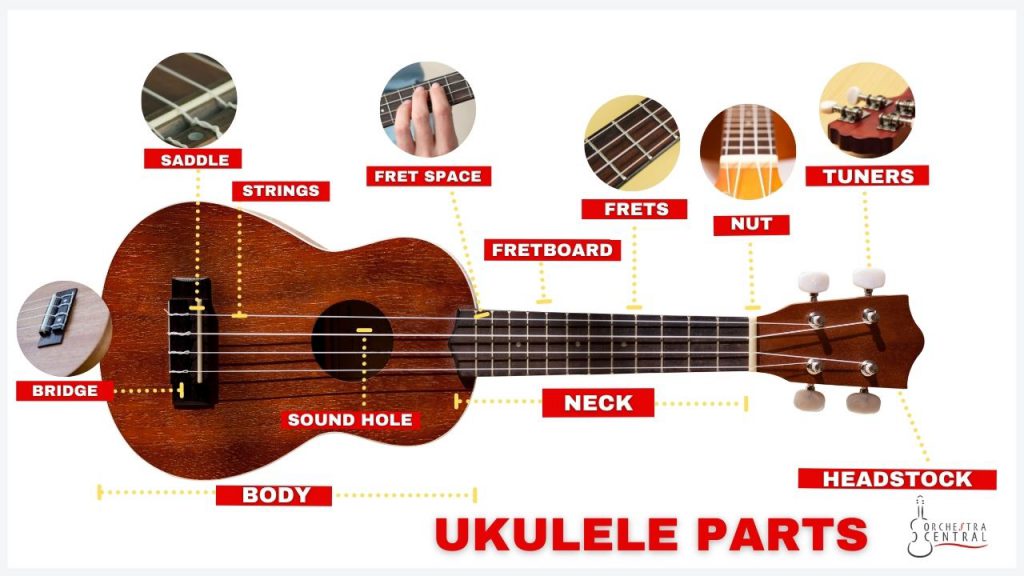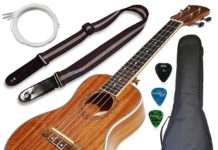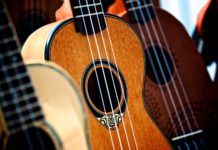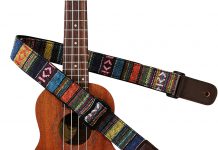The fretboard and headstock are some of the well-known parts of a ukulele. But did you know that this small stringed instrument has more than ten components? And, there is even a part that is often overlooked yet is responsible for keeping the strings in place.
12 Parts of a Ukulele

Each part of a ukulele is significant in delivering the sweet and bright tune that everyone loves. So, what are these components and what is their purpose? Here is a closer look at all the ukulele parts’ names.
1. Headstock
The headstock is located at the top of the neck and usually has the manufacturer’s logo. This ukulele part is generally made from solid wood because it keeps the tuners and strings in place. Plastic headstocks are also available but are more prone to breakage or snapping.
When choosing a headstock, you’ll often find two options – solid and slotted. With a solid headstock, you will find the strings and tuning pegs outside or on the back. On the other hand, a slotted headstock has slots where the strings rest. This design also has its tuning pegs on the outside of the headstock.
2. Tuners
The tuners rest on the headstock. This part is often called tuning pegs, tuning keys, tuning heads, or machine heads because of the many changes in their design over time. There are usually four tuning pegs, but there can be as many as eight.
Here is a quick guide If you’re installing new strings on your ukulele:
Thread the strings through the tuners. Then, you turn the tuning pegs to change a string’s pitch. You tighten strings to make higher pitches and loosen strings to make lower pitches.
Pro tip: Before tightening strings, you’ll want to unwind the tuners to avoid over-stretching and breakage.
3. Nut
The part between the headstock and the fretboard is called the nut. It’s a small ridge with evenly-spaced notches for each string to rest before going to the tuners. The nut is a few millimeters above the fretboard. The ukulele would be unplayable without it.
4. Fretboard
The fretboard stretches from the nut to the body in front of the neck. It’s a smooth, flat piece that holds frets in place, usually made of strong, dark hardwood (like ebony or rosewood). You make notes higher by pushing the strings down onto it.
The fretboard is 12 to 19 frets long. This part is usually marked at the fifth, seventh, tenth, and twelfth frets to help you quickly and easily navigate the fretboard. These markers are called fret markers, fret dots, or position markers. They are usually white dots, but you’ll find some ukes that use other shapes and colors.
5. Frets
The fretboard also consists of metal bars called frets. This part of the ukulele divides the fretboard according to the pitches of notes. Although most ukes have frets, there are fretless models which grant more musical freedom. However, they are best suited for professionals who are already accustomed to the pitch or sound.
The frets divide the fretboard into half steps. Frets are furthest apart near the nut and closest together near the sound hole. The difference between semi-tones gets smaller as the string is made shorter.
6. Fret Space
The ukulele parts name for the space on the fretboard between frets is simply a fret space. The fret space is where you hold down the string against the fret to form notes or chords. The fret spaces get smaller the closer you get to the sound hole.
7. Body
The largest of the ukulele parts is its body or soundbox. Its size depends on its type: soprano, concert, tenor, and baritone. The body has a top, back, and sides which have a middle (waist), upper bout (shoulders), and lower bout (hips).
Solid wood bodies have a rich sound that laminate ukes don’t. Laminate ukuleles are less durable because they’re created by pressing together pieces of wood.
Standard bodies deliver full-sounding lower tones. Bodies with cutaways or scallops (where part of the shoulder is missing) don’t have the same fullness. However, it’s easier to access the bottom of the fretboard.
8. Strings
Ukulele strings are chosen and tuned according to the instrument’s size. Usually, concert and soprano ukes have nylon strings, and tenor and baritone ukes have a nylon and metal mix. Lower pitch metal strings produce a fullness that nylon can’t replicate. However, it’s common for tenor ukuleles to use high G strings made of nylon instead of the metal-wound low G strings.
Strings dull and dent, and tones get flatter. You’ll need to change these to keep them from breaking. After changing them, you’ll need to re-tune the strings regularly.
9. Saddle
The saddle is located on top of the bridge by the sound hole. Like the nut, this ukulele part holds the strings above the fretboard. Small notches in the saddle keep the strings an equal distance apart from one another. You can remove the saddle.
10. Bridge
The bridge rests on top of the body near the sound hole. It secures the strings to the body and transfers each vibration to the body. Strings are knotted and strung through the bridge. The bridge undergoes a lot of tension and is commonly a failure point of the instrument.
11. Neck
The neck stretches from the body to the headstock and supports the fretboard. It’s curved so you can cup your hand around it and play more comfortably. The heel is the part of the neck that joins the body and is usually where a strap button is attached.
Solid wood usually makes up the neck, headstock, and fretboard. Sometimes the fretboard is glued onto the neck. Either way, it must be sturdy enough to withstand the tension of the strings.
12. Sound Hole
The sound hole is a (usually) circular hole located in the center of the body. Others are offset or dual. The rosette is an inlaid pattern that decorates the sound hole of some ukes.
The vibrations go into the body through the bridge. The sounds caused by the vibrations reverberate inside and project from the sound hole. You produce the loudest and deepest sound when you strum above it and more mellow sounds when you strum further up the neck.
Conclusion
And, there you have it; a ukulele has 12 parts consisting of the headstock, tuners, nut, fretboard, frets, fret spaces, body, strings, saddle, bridge, neck, and sound hole. All of which work together to produce beautiful sounds unique from any other instrument.
Table of Contents






